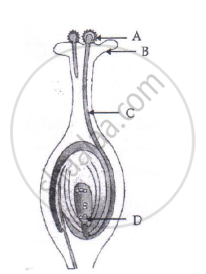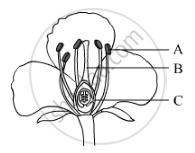Advertisements
Advertisements
प्रश्न
__________ is present in unisexual flower.
पर्याय
Both androecium and gynoecium
Only androecium
Only gynoecium
Androecium or gynoecium
उत्तर
Androecium or gynoecium is present in unisexual flower.
APPEARS IN
संबंधित प्रश्न
A student was asked to observe and identify the various parts of an embryo of a red kidney bean seed. He identified the parts and listed them as under:
I. Tegmen
II. Testa
III. Cotyledon
IV. Radicle
V. Plumule
The correctly identified parts among these are
(A) I, II and III
(B) II, III and IV
(C) III, IV and V
(D) I, III, IV and V
In the following diagram showing the structure of embryo of a dicot seed, what are the parts marked I, II and III sequentially?


(i) Name the part marked 'A' in the diagram.
(ii) How dose 'A' reachese part 'B'?
(iii) State the importance of the part 'C'.
(iv) What happens to the part marked 'D' after fertilisation is over?
Name the parts A, B and C shown in the following diagram and state one function of each.

You are asked by your teacher to study the different parts of an embryo of a gram seed. Given below are the steps to be followed for the experiment:
I. Soak the gram seeds in plain water and keep them overnight.
II. Cut open a soaked seed and observe its different parts.
III. Take some dry gram seeds in a petri dish.
IV. Drain the excess water.
V. Cover the soaked seeds with a wet cotton cloth and leave them for a day.
The correct sequence of these steps is :
(A) III, I, V, IV, II
(B) III, I, II, IV, V
(C) III, IV, V, I, II
(D) III, I, IV, V, II
Write the names of those parts of a flower which serve the same function as the following do in the animals :
(i) testis,
(ii) sperm,
(iii) ovary,
(iv) egg
Name the part made up of the stigma, style and ovary.
Fill in the following blank with suitable word :
The term used to refer to the transfer of pollen from the stamen of one flower to the carpel of another flower of the same species is...........
Draw a neat sketch of the carpel of a flower. Mark in it stigma, style and ovary.
How do the insects help in cross-pollination?
Give some examples of different modes of fertilisation in nature?
Describe the process of fertilisation in a flower with the help of labelled diagrams.
Which of the following statements are true for flowers?
(i) Flowers are always bisexual.
(ii) They contain sexual reproductive organs.
(iii) They are produced in all groups of plants.
(iv) after fertilization they give rise to fruits.
In a bisexual flower, inspite of the young stamens being removed artificially, the flower produces fruit. Explain.
Fill in the blank by selecting suitable word:
A flower that bears both the male and the female parts is known as __________ flower.
What is a flower ? Draw a neat labelled diagram showing the L.S. of a typical flower.
Fill in the blank:
Seeds are formed from________.
State whether the following statement is true (T) or false (F):
Flowers which possess stamens and carpel are called unisexual.
Mention the function of Flower.
Draw a labelled diagram of a bisexual flower.
A student is asked to study the different parts of an embryo of pea seeds. Given below are the essential steps for the experiment :
(I) Soak the pea seeds in plain water and keep them overnight.
(II) Cut open the soaked seed and observe its different parts.
(III) Take some pea seeds in a petri dish.
(IV) Drain the excess water. Cover the seeds with a wet cotton cloth and leave them as it is for a day.
The correct sequence of these steps is
(A) III, I, IV, II
(B) III, IV, I, II
(C) III, I, II, IV
(D) III, II, I, IV
Sketch the labeled diagram:
Flower with its sexual reproductive organs
Explain sexual reproduction in plants.
Prepare a slogan for campaign against female foeticide.
A student is observing the temporary mount of a leaf peel under a microscope. Draw a labelled diagram of the structure of stomata as seen under the microscope
What is cleistogamy? Write one advantage and one disadvantage of it, to the plant.
What is meant by pollination?
Give scientific reason.
Flower is a structural unit of sexual reproduction in plants.
Identify the parts A, B, C, and D?

The anther wall consists of four wall layers where ______
Flowers showing ornithophily show few characteristic like ______.
The flower of the Hibiscus plant is ______
Which among the following statements are true for sexual reproduction in flowering plants?
- It requires two types of gametes
- Fertilisation is a compulsory event
- It always results in formation of zygote
- Offspring formed are clones
In a bisexual flower inspite of the young stamens being removed artificially, the flower produces fruit. Provide a suitable explanation for the above situation.
Give reason for the following:
Fertilization cannot take place in flowers if pollination does not occur.
Name the reproductive parts of an angiosperm. Where are these parts located? Explain the structure of its male reproductive part.
The pollen tube usually enters the embryo sac ______.
